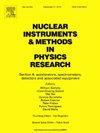Signal properties study of neutron irradiated silicon photomultipliers down to 100 K
IF 1.5
3区 物理与天体物理
Q3 INSTRUMENTS & INSTRUMENTATION
Nuclear Instruments & Methods in Physics Research Section A-accelerators Spectrometers Detectors and Associated Equipment
Pub Date : 2025-07-16
DOI:10.1016/j.nima.2025.170833
引用次数: 0
Abstract
The LHCb experiment at CERN has been upgraded for the Run 3 operation of the Large Hadron Collider (LHC). A new concept of tracking detector based on Scintillating Fibres (SciFi) read out with multichannel silicon photomultipliers (SiPMs) was installed during its upgrade. One of the main challenges the SciFi tracker will face during its operation is the high radiation environment due to fast neutrons, where the SiPMs are located. In view of LHCb Upgrade II in 2033, the radiation levels will increase significantly, and the SciFi tracker must undergo a major upgrade. By the end of the lifetime, the expected radiation fluence will reach at the SiPMs’ location. To cope with the increase in radiation, cryogenic cooling with liquid nitrogen is being investigated as a possible solution to mitigate the performance degradation of the SiPMs induced by radiation damage. Thus, a detailed performance study of different layouts of SiPM modules produced by FBK and Hamamatsu is being carried out. These detectors have been designed to operate at cryogenic temperatures. Several detectors were irradiated with different neutron fluences and tested in a dedicated cryogenic setup down to 100 K. Key performance parameters, such as breakdown voltage, quenching resistor value, recovery time, and pulse amplitude, are characterized as a function of temperature and neutron fluence. Also, the forward voltage diode as a function of temperature was measured, and the silicon energy bandgap was estimated. The main results of this study are going to be presented here.
100k以下中子辐照硅光电倍增管的信号特性研究
欧洲核子研究中心的大型强子对撞机实验已经升级为大型强子对撞机(LHC)的第三次运行。在对其进行升级的过程中,安装了一种基于多通道硅光电倍增管的闪烁光纤读出跟踪探测器的新概念。SciFi跟踪器在运行过程中将面临的主要挑战之一是由于快速中子的高辐射环境,而sipm位于该环境中。鉴于2033年LHCb升级II,辐射水平将显著增加,科幻跟踪器必须进行重大升级。在寿命结束时,sipm位置的预期辐射通量将达到3.0×1012neqcm−2。为了应对辐射的增加,人们正在研究液氮低温冷却作为减轻辐射损伤引起的sipm性能下降的可能解决方案。因此,对FBK和滨松生产的SiPM模块的不同布局进行了详细的性能研究。这些探测器被设计成在低温下工作。几个探测器以不同的中子通量照射,并在专用的低温装置中进行了低至100 K的测试。关键的性能参数,如击穿电压、淬火电阻值、恢复时间和脉冲幅度,表征为温度和中子通量的函数。测量了二极管的正向电压随温度的变化规律,并对硅能带隙进行了估计。本研究的主要结果将在这里介绍。
本文章由计算机程序翻译,如有差异,请以英文原文为准。
求助全文
约1分钟内获得全文
求助全文
来源期刊
CiteScore
3.20
自引率
21.40%
发文量
787
审稿时长
1 months
期刊介绍:
Section A of Nuclear Instruments and Methods in Physics Research publishes papers on design, manufacturing and performance of scientific instruments with an emphasis on large scale facilities. This includes the development of particle accelerators, ion sources, beam transport systems and target arrangements as well as the use of secondary phenomena such as synchrotron radiation and free electron lasers. It also includes all types of instrumentation for the detection and spectrometry of radiations from high energy processes and nuclear decays, as well as instrumentation for experiments at nuclear reactors. Specialized electronics for nuclear and other types of spectrometry as well as computerization of measurements and control systems in this area also find their place in the A section.
Theoretical as well as experimental papers are accepted.

 求助内容:
求助内容: 应助结果提醒方式:
应助结果提醒方式:


